News tagged ‘browser’
Updates in Cydia: iComing, myFox, LockDown
Couple more updates today.
![]() iComing allows you to be alerted when you are reaching a target location and / or send an sms to warn someone that you are coming. It uses GPS, GSM cells and WiFi. iComing updated to version 0.3.
iComing allows you to be alerted when you are reaching a target location and / or send an sms to warn someone that you are coming. It uses GPS, GSM cells and WiFi. iComing updated to version 0.3.
![]() is an alternative browser for iPhone. Updated to version 1.3.
is an alternative browser for iPhone. Updated to version 1.3.
![]() allows users to protect iPhone applications with a password. Updated to version 4.0.
allows users to protect iPhone applications with a password. Updated to version 4.0.
All these applications are avaliable via .
myFox - Firefox for iPhone?
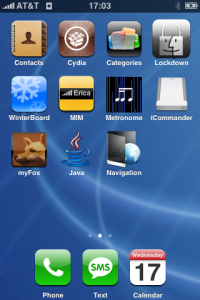

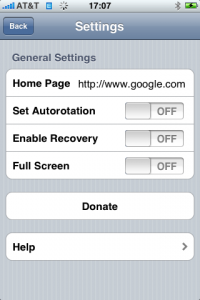
This is a Safari replacement browser for iPhone. It is avaliable via Cydia (Networking category).
- Full Screen Browsing
- Turn Landscape Mode switch on and off
- Bookmarks
- URL Recovery
- Home Page
- Google Search
- Mail Link
It is still in development stage, so more features will be quite soon.
 Leave a comment, read comments [1]
Leave a comment, read comments [1]
iFunBox - iPhone file browser
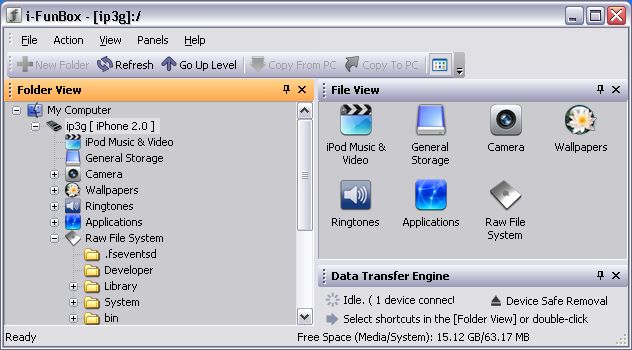
iFunBox is an iPhone file browser for MS Windows. It is quite useful. I use iPhoneBrowser tool, and this one I like very much. It is free, download .
| iPhone File Manager > Navigation, Upload and Download > Quick Preview, Drag&Drop > Delete, Rename and Move > Asian / Long Filename Support |
iPhone Portable Disk > Realtime Progress Indicator > High Speed Data Transmission > Scheduled Data Transferring > Recursive Copy Subfolders |
Managing iPod Music & Movie > iTunes© Managed Media Files > Upload Songs and Movie > Sort and Selection > Copy to PC with Friendly Title |
Upload Wallpaper in Batch > Wallpapers in iPhone > Batch Uploading and Conversion > Change Image Resolution > High Quality Image Resizing |
 Leave a comment, read comments [2]
Leave a comment, read comments [2]
Block ads in Safari browser
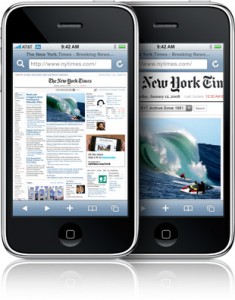
Jamesisbored published a guide, that shows how to block ads, that show up in Safari browser during web surfing.
MobileSafari has one major drawback. Up until now, there was no way to block ads. Ads increase the load time of a webpage, and especially on EDGE cause the internet to crawl. Blocking them will give you a lot of extra speed. This is one of the simplest hacks available for your iPhone. You will need to be Jailbroken and have the 2.0 Update, or later.
- Connect to your iPhone through SSH, iPhoneBrowser, or some other tool.
- Navigate to /etc/.
- Now download replacement hosts file. Replace iPhone's file with this one.
- Restart your iPhone!
This hack has been tested and confirmed to be working on the iPhone 2.1 Update.
OpenClip - Copy/Paste for iPhone

One of the common complaints about Apple’s iPhone–and one that did not get solved with the launch of the iPhone 3G–is the lack of a copy-paste function. An independent developer Zac White has taken matters in his own hands and founded a non-profit, open source, community project called which is offering iPhone developers a free Copy and Paste framework that will add this functionality to their applications.
Customize 2.1 for firmware 2.0

This application was quite popular. It allows to modify look and feal of your Iphone: icons, slider icon, battery indicator, wi-fi/gsm indicators, dock, keyboard, chat, sounds and mcuh more.
What's new:
- Theme Browser: you can download them directly from this application, no ssh as before.;
- Elements of themes can be used partially (just sounds, foe example);
- User themes can be downloaded through the web site.
Install through Cydia. Source: Hack&Dev Team Source.
via iphoneapps
Get internet on a desktop or notebook through IPhone 3G
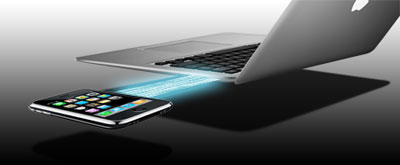
Thanks to and the porting work of as well as the authors of , it is now possible to "tether" your iPhone 3G and use its Internet connection on your laptop.
Warning - Tethering your iPhone is against the iPhone data plan terms. AT&T could slap you with huge fees if you overuse this. I recommend only using it during emergencies.
Here is a basic plan (by the way, this should work for old IPhone also):
- Jailbreak your iPhone 3G
- Install 3Proxy and Terminal
- Create an ad-hoc Wi-fi network using your laptop
- Join the network with your iPhone
- Find the iPhone's IP address
- Open Terminal and run the proxy program
- Open Safari on your iPhone and open a web page
- Configure your browser to use the proxy
Later we'll discuss it with more details.
Step 1: Jailbreak your iPhone
 Leave a comment, read comments [3]
Leave a comment, read comments [3]
Safari benchmark - 2.0 is faster than 1.1.4
There is not much defference between Safari 1.1.4 and 2.0. But Under the hood, MobileSafari 2.0's performance is hugely improved over 1.1.4. Everything related to web surfing feels faster, web pages consistently load faster on 2.0, both via Wi-Fi and EDGE. This has nothing to do with the new iPhone 3G hardware — this is about dramatic performance improvements on original iPhones upgraded to the 2.0 OS.
Using MobileSafari simply feels faster, especially with web applications. Feel is by nature subjective, but JavaScript benchmarks back this up.
In August last year, to compare the iPhone's processing power and JavaScript interpreter against Safari 3 running on a Mac with a 1.83 GHz Core Duo. At that time, the current version of the iPhone OS was 1.0.1. Here are the results of those same benchmarks on original iPhones running the 1.1.4 and new 2.0 OS versions, with Hockenberry’s 1.0.1 results included for comparison:
| Test | 1.0.1 | 1.1.4 | 2.0 | Vs. 1.0.1 / 1.1.4 |
|---|---|---|---|---|
| 100,000 iterations | 3.209 | 1.096 | 0.145 | 22× / 8× |
| 10,000 divisions | 0.413 | 0.181 | 0.029 | 14× / 6× |
| 10,000 sin(x) calls | 0.709 | 0.373 | 0.140 | 5× / 3× |
| 10,000 string allocations | 0.777 | 0.434 | 0.133 | 6× / 3× |
| 10,000 function calls | 0.904 | 0.595 | 0.115 | 8× / 5× |
The last column shows how many times faster the 2.0 version of MobileSafari was versus 1.0.1 and 1.1.4. The same results, charted (smaller bars are faster) can be viewed above.
The results are obvious. WebKit JavaScript performance has improved steadily and significantly in just one year, with a huge jump between 1.1.4 and the new 2.0.0. In side-by-side page loading tests between two original iPhones running 1.1.4 and 2.0.0, the new version consistently finished at least a few seconds faster.
For all the hubbub regarding the new App Store, most “iPhone software” runs in the web browser. But improvements in WebKit performance often help native iPhone app performance, too — a slew of my favorite native iPhone apps have built-in WebKit browsers (e.g., NetNewsWire, Twitterrific, Instapaper, and Cocktails). When WebKit performance improves, any app that uses WebKit improves, and WebKit improved a lot between iPhone 1.1.4 and 2.0.0.
via daringfireball.net
iPhone Configuration Utility
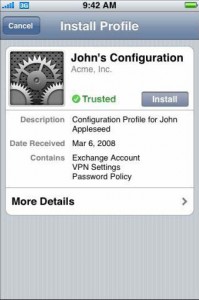
iPhone Configuration Utility lets you create configuration profiles for your devices. There are two versions of iPhone Configuration Utility—one is a Mac OS X application and the otheris a web-based version for Mac OS X or Windows. Application-based looks a bit different, has more functionality, but web-based could be used on windows platform.
After installation of Web utility open a web browser and go to: http://localhost:3000. Log in with the user name admin and the password admin. You're all set. Create profiles and distribute them by email or web.
There are several tabs here:
Tutorial: compile and run Java application on the IPhone

This is a tutorial, that shows step by step how to use installed Java on the IPhone. Just in case you do not have Java installed on your IPhone there is a how to do it.
What we need is a working IPhone with . I used latest firmware 1.1.4, unlocked, jailbreaked and customized by .
Step 1: Create simple Java application, compile and run.
 Leave a comment, read comments [16]
Leave a comment, read comments [16]
IPhone's new patent application

Apple a new patent application (us20080122796ki). On more than 370 pages lots of new potential features and enhancements for IPhone’s hardware and software are described.
The most interesting Hardware part is a GPS receiver and a camera for video conferencing.
On a software level, Apple describes addition of a text messaging (chat), in-line multimedia content (Quicktime and Flash) in the Safari browser. Further welcome additions described in the publication would include a dedicated blogging client, Java software downloads, MMS picture and video messaging, support for voice-activated commands, audio capture, video conferencing and more.
“[0142]Examples of other applications 136 that may be stored in memory 102 include other word processing applications, JAVA-enabled applications, encryption, digital rights management, voice recognition, and voice replication. ”
It sounds like Apple wants Java to be on the IPhone ![]()
 Leave a comment, read comments [2]
Leave a comment, read comments [2]